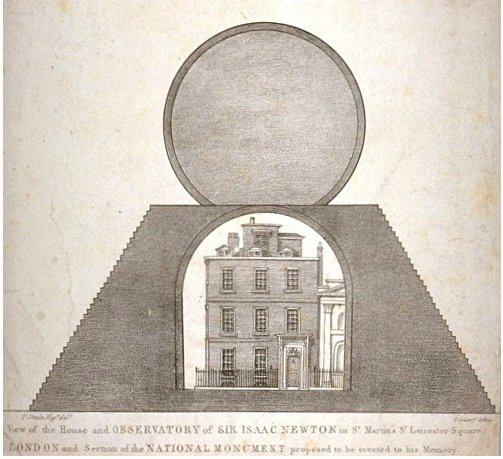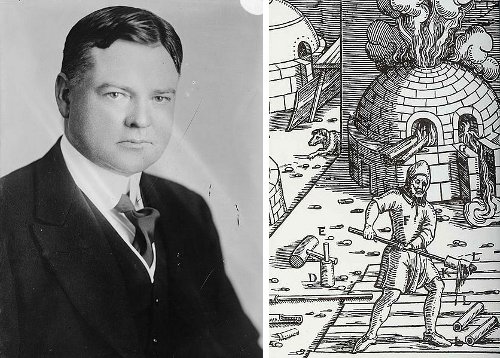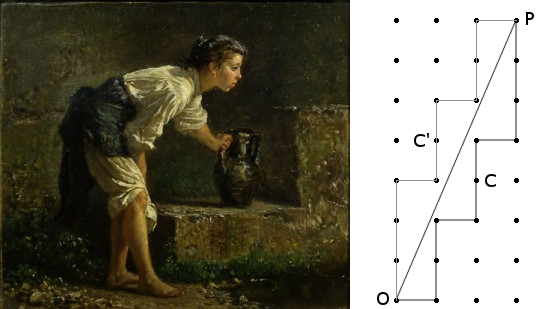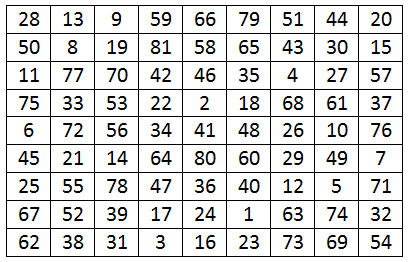Prove that the product of four consecutive positive integers cannot be a perfect square.
Science & Math
Dinner Charge
A curious effect produced by lightning is described to us by Dr. Enfield, writing from Jefferson, Iowa, U.S. A house which he visited was struck by lightning so that much damage was done. After the occurrence, a pile of dinner plates, twelve in number, was found to have every other plate broken. It would seem as if the plates constituted a condenser under the intensely electrified condition of the atmosphere. The particulars are, however, so meagre that it is difficult to decide whether the phenomenon was electrical or merely mechanical.
— Nature, June 12, 1902
A Body at Rest

In an anonymous letter to the London Times in 1825, Thomas Steele of Magdalen College, Cambridge, proposed enshrining Isaac Newton’s residence in a stepped stone pyramid surmounted by a vast stone globe. The physicist himself had died more than a century earlier, in 1727, and lay in Westminster Abbey, but Steele felt that preserving his home would produce a monument “not unworthy of the nation and of his memory”:
When travelling through Italy, I was powerfully struck by the unique situation and singular appearance of the Primitive Chapel at Assisi, founded by St. Francis.
As you enter the porch of the great Franciscan church, you view before you this small cottage-like chapel, standing directly under the dome, and perfectly isolated.
Now, Sir, among the many splendid improvements which are making in the capital, would it not be a noble, and perhaps the most appropriate, national monument which could be erected, if an azure hemispherical dome, or what would be better, a portion of a sphere greater than a hemisphere, supported on a massive base, were to be reared, like that of Assisi, over the house and observatory of the writer of the Principia?
The house might be fitted up in such a manner as to contain a council-chamber and library for the Royal Society; and it is perhaps not unworthy of being remarked, that it is not more than about two hundred yards distant from the University Club House.
Protected, by the means which I have described, from the dilapidating influence of rains and winds, the venerable edifice in which Newton studied, or was inspired, — that ‘palace of the soul,’ might stand fast for ages, a British monument more sublime than the Pyramids, though remote antiquity and vastness be combined to create their interest.
Steele wasn’t an architect, and he left the details to others, but he was imagining something enormous: In a subsequent letter to the Mechanics’ Magazine he wrote that “the base of my design [appears] to coincide with the base of St. Paul’s (a sort of crude coincidence of course, in consequence of the angle at the transept), and that the highest point of my designed building should, at the same time, appear to coincide with a point of the great tower of the cathedral, about 200 feet high — the height of the building which I propose to have erected.”
The plan never went forward, but the magazine endorsed the idea: “We need scarcely add, that there is no description of embellishment which might not be with ease introduced into the structure, so as to render it as perpetual a monument to the taste as it would be to the national spirit and gratitude of the British people.”
Warm Words

Future president Herbert Hoover published a surprising title in 1912: An English translation of the 16th-century mining textbook De Re Metallica, composed originally by Georg Bauer in 1556. Bauer’s book had remained a classic work in the field for two centuries, with some copies deemed so valuable that they were chained to church altars, but no one had translated the Latin into good modern English. Biographer David Burner wrote, “Hoover and his wife had the distinct advantage of combining linguistic ability with mineralogical knowledge.”
Hoover, a mining engineer, and his wife Lou, a linguist, spent five years on the project, visiting the areas in Saxony that Bauer had described, ordering translations of related mining books, and spending more than $20,000 for experimental help in investigating the chemical processes that the book described.
The Hoovers offered the 637-page work, complete with the original woodcuts, to “strengthen the traditions of one of the most important and least recognized of the world’s professions.” Of the 3,000 copies that were printed, Hoover gave away more than half to mining engineers and students.
Yablo’s Paradox
All the statements below this one are false.
All the statements below this one are false.
All the statements below this one are false.
All the statements below this one are false.
All the statements below this one are false.
…
These statements can’t all be false, because that would make the first one true, a contradiction. But neither can any one of them be true, as a true statement would have to be followed by an infinity of false statements, and the falsity of any one of them implies the truth of some that follow. Thus there’s no consistent way to assign truth values to all the statements.
This is reminiscent of the well-known liar paradox (“This sentence is false”), except that none of the sentences above refers to itself. MIT philosopher Stephen Yablo uses it to show that circularity is not necessary to produce a paradox.
Finding Mates
A remarkable spelling trick by American magician Howard Adams:
From a deck of cards choose five cards and their mates. A card’s mate is the card of the same value and color; for example, the mate of the five of clubs is the five of spades.
Arrange the cards in the order ABCDEabcde, where ABCDE are the chosen cards and abcde are the mates. Cut this packet as many times as you like, then deal five cards onto the table, reversing their order. Place the remaining five cards beside them in a second pile.
Now spell the phrase LAST TWO CARDS MATCH. As you say “L,” choose either pile at random and transfer a card from the top to the bottom. Do the same for A, S, and T. Now remove the top card from each pile and set them aside as a pair.
Perform the same procedure as you spell TWO, CARDS, and MATCH. When you’re finished, two cards will remain on the table. Not only do these cards match, but so do each of the other pairs!
Well Done

Using a 7-quart and a 3-quart jug, how can you obtain exactly 5 quarts of water from a well?
That’s a water-fetching puzzle, a familiar task in puzzle books. Most such problems can be solved fairly easily using intuition or trial and error, but in Scripta Mathematica, March 1948, H.D. Grossman describes an ingenious way to generate a solution geometrically.
Let a and b be the sizes of the jugs, in quarts, and c be the number of quarts that we’re seeking. Here, a = 7, b = 3, and c = 5. (a and b must be positive integers, relatively prime, where a is greater than b and their sum is greater than c; otherwise the problem is unsolvable, trivial, or can be reduced to smaller integers.)
Using a field of lattice points (or an actual pegboard), let O be the point (0, 0) and P be the point (b, a) (here, 3, 7). Connect these with OP. Then draw a zigzag line Z to the right of OP, connecting lattice points and staying as close as possible to OP. Now “It may be proved that the horizontal distances from OP to the lattice-points on Z (except O and P) are in some order without repetition 1, 2, 3, …, a + b – 1, if we count each horizontal lattice-unit as the distance a.” In this example, if we take the distance between any two neighboring lattice points as 7, then each of the points on the zigzag line Z will be some unique integer distance horizontally from the diagonal line OP. Find the one whose distance is c (here, 5), the number of quarts that we want to retrieve.
Now we have a map showing how to conduct our pourings. Starting from O and following the zigzag line to C:
- Each horizontal unit means “Pour the contents of the a-quart jug, if any, into the b-quart jug; then fill the a-quart jug from the well.”
- Each vertical unit means “Fill the b-quart jug from the a-quart jug; then empty the b-quart jug.”
So, in our example, the map instructs us to:
- Fill the 7-quart jug.
- Fill the 3-quart jug twice from the 7-quart jug, each time emptying its contents into the well. This leaves 1 quart in the 7-quart jug.
- Pour this 1 quart into the 3-quart jug and fill the 7-quart jug again from the well.
- Fill the remainder of the 3-quart jug (2 quarts) from the 7-quart jug and empty the 3-quart jug. This leaves 5 quarts in the 7-quart jug, which was our goal.
You can find an alternate solution by drawing a second zigzag line to the left of OP. In reading this solution, we swap the roles of a and b given above, so the map tells us to fill the 3-quart jug three times successively and empty it each time into the 7-quart jug (leaving 2 quarts in the 3-quart jug the final time), then empty the 7-quart jug, transfer the remaining 2 quarts to it, and add a final 3 quarts. “There are always exactly two solutions which are in a sense complementary to each other.”
Grossman gives a rigorous algebraic solution in “A Generalization of the Water-Fetching Puzzle,” American Mathematical Monthly 47:6 (June-July 1940), 374-375.
A Magic Mystery

In 1991, David Collison sent this figure to Canadian magic-square expert John Henricks, with no explanation, and then died.
It’s believed to be the first odd-ordered bimagic square ever discovered. Each row, column, and diagonal produces a sum of 369. The square remains magic if each number is squared, with a magic sum of 20,049.
No one knows how Collison created it.
UPDATE: Wait, Collison’s wasn’t the first — G. Pfeffermann published a 9th-order bimagic square as a puzzle in Les Tablettes du Chercheur in 1891. (Thanks, Baz.)
Regrets
On June 28, 2009, Stephen Hawking hosted a party for time travelers, but he sent out the invitations only afterward.
No one turned up.
He offered this as experimental evidence that time travel is not possible.
“I sat there a long time,” he said, “but no one came.”
Misc
- To frustrate eavesdroppers, Herbert Hoover and his wife used to converse in Chinese.
- Asteroids 30439, 30440, 30441, and 30444 are named Moe, Larry, Curly, and Shemp.
- COMMITTEES = COST ME TIME
- 15618 = 1 + 56 – 1 × 8
- How is it that time passes but space doesn’t?
Webster’s Third New International Dictionary gives no pronunciation for YHWH.
